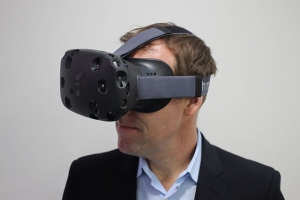
One of the biggest challenges in university classrooms today is keeping up with technology that is moving at warp speed. First, there were computers and laptops. They were quickly augmented with mobile devices – smartphones and tablets. Distance learning crept in as students took classes remotely. And now, 3D printing is in high demand on nearly every college campus.
So what’s the next big thing? There is only one answer to that question – virtual reality!
Virtual reality (VR) creates a computer-generated environment that is three-dimensional. Users of VR are able to interact with all kinds of things in that environment. Objects in the VR environment can be manipulated through electronics and the experience is amazingly real. VR is changing many segments of everyday life. The most recognized piece of equipment may be a helmet like those used in PlayStation systems or glasses that are worn by users.

By Maurizio Pesce – CC BY 2.0
But, virtual reality is more than a toy or game. College campuses throughout the country are fighting to research VR technology and they are humming with innovative ways to use VR systems to improve teaching and learning.
Texas A&M is among many universities throughout the country that use virtual reality for potential students to “tour” their campuses. Without traveling to College Station, young men and women can enjoy an impressive virtual tour of the university campus. A special A&M app facilitates tours, provides all kinds of information and provides a 360-degree panoramic view of the campus.
Many universities have online tours on their web sites, but the new “hot” thing is to have an impressive virtual reality tour, where there is a perception of being physically present in a software-created world that intensifies the experience. Texas Tech University also features such a tour on its web site and visitors are invited to enjoy an impressive tour that includes all of the university’s most attractive facilities.
In spite of the fact that marketing a university may be one of the least of VR’s capabilities, these tours are impressive and they are producing the desired results.
The University of Houston’s foray into virtual reality began many years ago and it has taken a different track. In 2002, the university created a VR clinical research lab to treat addictions and mental health disorders. That work continues today but now VR capabilities are being used to treat anxiety and substance abuse. VR technology at UH is not only addressing addictions and dependencies, but it is also addressing problems related to social behavior and mental health issues.
At The University of Texas at San Antonio (UTSA), engineers are busy developing applications for possible uses for virtual reality. In 2009, UTSA established its Center for Simulation, Visualization and Real-Time Prediction, which includes the Advanced Visualization Lab (VizLab). The university now offers a master’s of science in data visualization program. The program is designed to help faculty and students explore new uses for virtual reality, big data and imaging.
VR systems also are becoming part of the increasing use of immersive media. At the highly celebrated South by Southwest® Conference & Festivals in Austin earlier this year, representatives of The University of Texas at Austin’s Moody College of Communication hosted a session on “Using Virtual Reality in Storytelling.” At this session, VR experts discussed their partnership with The Washington Post and explained ongoing projects designed to create VR content. Readers in the future may experience news in a much more intense way than in the past.
Technology is increasingly important on college campuses – whether being used to recruit and retain students or to ensure that student experiences in the classroom mirror the real day-to-day digital world. This next big thing – virtual reality – will only increase the size of the technology marketplace in higher education. Texans who are no longer spending time on university campuses or immersed in technology should watch this trend carefully because VR may become a part of everyday life in the very near future.
Want to read more stories like this one? Check out the most recent editions of Government Contracting Pipeline and Texas Government Insider. SPI’s government contracting consultants assist firms of all types in selling to government. Contact them today.
